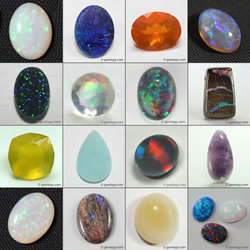 Opal is the October birthstone. Most people think of the white Australian variety when they think of opal; however opal comes in many colors and from many places. Opal is formed over a very long period of time from water and silica flowing into the cracks of rocks and hardening.
Opal is the October birthstone. Most people think of the white Australian variety when they think of opal; however opal comes in many colors and from many places. Opal is formed over a very long period of time from water and silica flowing into the cracks of rocks and hardening. In addition to white Australian opal, there is black and grey Australian opal as well. Most of the Australian opals are called precious opal, which means they have a play of color that has different spectral colors that change with the viewing angle of the opal. Opals without a play of color are called common opals. White and black opals are also found in Nevada and Idaho.
Another source for precious opal was recently found in Ethiopia. Poor quality brown ones were first found in the Mezezo region, but another source was found in 2008 in the Wollo region, that produced prettier, more stable opals with great play of color. Many of the opals from the region have a slight orangish body color to them.
Fire opals, not to be mistaken for fiery opals, are usually a common opal without the play of color, but a rich yellow orange to reddish orange body color. They form in volcanic flows in Mexico, Central and South America, as well as Idaho and Oregon.
Another type of common opal is Peruvian opal. Peruvian opal comes in a light to medium blue to greenish blue color, and also a pink variety. These opals don’t have a play of color, but are sometimes cut with dendritic/mosslike inclusions showing,
Some opals are not stable; that is, they dry out over time which can cause a hazy appearance or cracking called “crazing.” This is more common in fire opal and Peruvian blue opal. A good dealer will keep his opals under lamps to reveal which ones are unstable before they are sold.
Opals are a fun gemstone to wear. They offer a variety of body colors, and the precious ones have an explosion of colors which makes them an easy choice to pair with one’s wardrobe. Take care, however; opal is a delicate gemstone. Clean with a damp soft cloth. Avoid most jewelry cleaners, strong chemicals, oils and detergents. Remember to remove opal jewelry before bathing, showering or swimming.


